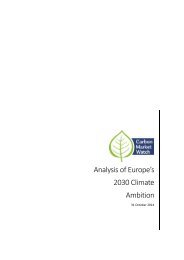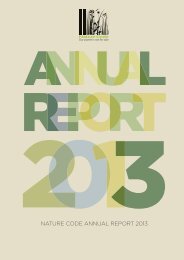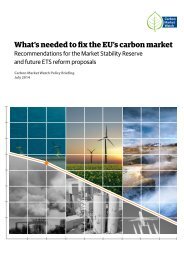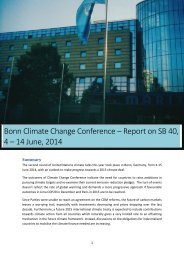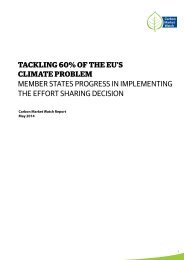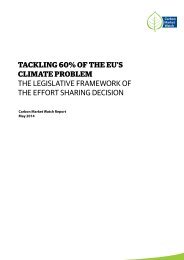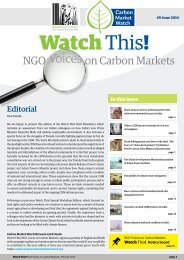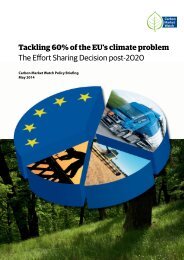THE ROLE OF INTERNATIONAL OFFSETS IN THE FUEL QUALITY DIRECTIVE
You also want an ePaper? Increase the reach of your titles
YUMPU automatically turns print PDFs into web optimized ePapers that Google loves.
<strong>THE</strong> <strong>ROLE</strong> <strong>OF</strong><br />
<strong><strong>IN</strong>TERNATIONAL</strong> <strong>OF</strong>FSETS <strong>IN</strong> <strong>THE</strong><br />
<strong>FUEL</strong> <strong>QUALITY</strong> <strong>DIRECTIVE</strong><br />
December 2014<br />
1
Executive summary<br />
The revised Fuel Quality Directive (FQD) has the objective of<br />
reducing the greenhouse gas intensity of transport fuels by 6% by<br />
2020, compared to 2010. Recently a revised proposal for a Council<br />
Decision to implement the FQD was adopted by the Council and<br />
the European Parliament.<br />
could be (or already have been) registered under Alberta’s offset<br />
system include the capture of carbon from tar sand operations<br />
for Enhanced Oil Recovery and the construction of road sections<br />
connecting the Shell tar sand mining activities to the highway and<br />
harbor.<br />
Fuel suppliers can meet the 6% target through various options such<br />
as blending biofuels, supplying electricity, hydrogen or other low<br />
carbon fuel. An additional option that has now been proposed in<br />
the FQD’s implementing measure is to reduce emissions through<br />
savings from emissions occurring prior to the raw material entering<br />
a refinery or a processing plant where the fuel was produced, so<br />
called Upstream Emissions Reductions (UERs). Depending on the<br />
use of first-generation biofuels, these UERs could provide 15% to<br />
50% of the overall 6% target. The overall effectiveness of the FQD’s<br />
decarbonisation objective is therefore very dependent on the way<br />
in which UERs lead to real and additional emission reductions.<br />
Various offsetting schemes could be used in order to implement,<br />
calculate and verify these upstream emission reductions. These<br />
offsetting programmes can generate offset credits from projects<br />
that reduce emissions in the fuel’s lifecycle. Existing offsetting<br />
programmes that could be eligible for supplying UERs include: the<br />
Clean Development Mechanism (CDM), Joint Implementation (JI)<br />
and the Alberta Offset System, a compliance mechanism for entities<br />
regulated under the Alberta’s mandatory GHG emission intensitybased<br />
regulatory system.<br />
Without further guidance by the European Commission, or<br />
restrictions by Member States, there is a substantial risk of<br />
double counted and non-additional offset credits being used for<br />
compliance with the FQD target, seriously undermining the FQD’s<br />
effectiveness in reducing the carbon footprint<br />
of transport fuels. Double counting can occur<br />
because:<br />
- The same offset credits are used by<br />
multiple Member States due to a lack<br />
of central oversight.<br />
- The same offset credits are redeemed<br />
by oil companies under both a third<br />
country’s compliance system (e.g.<br />
Alberta’s compliance system) and the<br />
FQD.<br />
- The same offset credits are used by oil<br />
companies for compliance with both<br />
the FQD and the EU ETS.<br />
Safeguards to ensure that credited projects would not have been<br />
expected to happen in a business as usual scenario are also lacking.<br />
Without additional safeguards, the Fuel Quality Directive could see<br />
offsets from tar sand operations being used both under Alberta’s<br />
compliance system as well as under the FQD. The projects that<br />
The FQD implementing measure does not specify which offsetting<br />
programmes qualify as upstream emission reductions, the only<br />
restriction is that the project should have started after 1 January<br />
2011. The Commission has been asked to provide non-binding<br />
guidance as regards to savings claimed from the UERs, but it will<br />
be up to the Member States to ensure in their national legislation<br />
that only additional projects that lead to real savings qualify for<br />
compliance with the FQD.<br />
We recommend that Member States limit upstream emission<br />
reductions to Clean Development Mechanism (CDM) projects<br />
in Least Developed Countries (LDCs). This significantly reduces<br />
the risks of double counting savings both under a third country’s<br />
compliance system and the FQD, as well as double counting<br />
between EU Member States. It also ensures consistency with the<br />
existing EU restrictions on international offsets, since credits from<br />
new projects registered after 2012 can only be used by companies<br />
under the EU ETS if the projects are located in Least Developed<br />
Countries. The same restrictions should apply to oil companies<br />
covered by the Fuel Quality Directive.<br />
The restriction to CDM projects in LDCs would also reduce the<br />
administrative burden of the European Commission and Member<br />
States, ensuring compliance with the FQD with little extra efforts.<br />
The CDM already fully prescribes the measurement, reporting and<br />
verification requirements to register emission savings and the<br />
eligible approved CDM methodologies<br />
are limited to venting or flaring projects.<br />
We recommend that<br />
Member States limit<br />
upstream emission<br />
reductions to Clean<br />
Development<br />
Mechanism (CDM)<br />
projects in Least<br />
Developed Countries<br />
(LDCs).<br />
The existing EU-centralized registry<br />
could furthermore be used for the<br />
FQD as well. The only additional check<br />
that is required is ensuring that offsets<br />
redeemed for compliance with the EU<br />
ETS are not at the same time also used<br />
for FQD compliance.<br />
The Commission has commissioned<br />
and recently released a study 1 which<br />
outlines four detailed approaches to<br />
upstream emission reduction crediting.<br />
Our proposal is consistent with the<br />
first option of the study (the ETS-CDM<br />
option) which has the potential to<br />
deliver even more than the emission<br />
reductions required to meet the full 6% GHG intensity reduction<br />
target. We urge the Commission to propose limiting the UERs to<br />
CDM projects in Least Developed Countries in order to ensure the<br />
highest level of environmental integrity and reduce administrative<br />
burden for national authorities.<br />
2
Contents<br />
Executive summary 2<br />
The Fuel Quality Directive 4<br />
Upstream Emission Reductions (UERs) 4<br />
ISO standards and offsetting programmes 5<br />
Examples of eligible offset programmes 5<br />
Alberta Offset System 6<br />
Clean Development Mechanism 6<br />
Joint Implementation 7<br />
Environmental integrity and carbon offsets 9<br />
Double counting of emission reductions 9<br />
Lessons learnt from offset use in EU’s climate policies 9<br />
Policy recommendations: eligibility criteria for UERs 10<br />
3
The Fuel Quality Directive<br />
In 2009, the Fuel Quality Directive (FQD) 2 was revised as part of the<br />
2020 climate and energy package to reduce the lifecycle emissions<br />
of the road transport fuels used in the European Union. A new<br />
target was set to reduce the greenhouse gas intensity of the fuels<br />
used in vehicles by 6% by 2020, compared to 2010, equaling a total<br />
reduction target of 54.8 million tonnes of CO 2<br />
-eq/year. The FQD<br />
applies to all petrol, diesel and biofuels used in road transport, as<br />
well as to gasoil used in non-road-mobile machinery.<br />
In order to meet this 6% target, the FQD introduces the Low Carbon<br />
Fuel Standard (Article 7a), which is a requirement on fuel suppliers<br />
to reduce the greenhouse gas intensity of energy supplied for road<br />
transport. The revised FQD also amends a number of elements<br />
of the petrol and diesel specifications, establishes sustainability<br />
criteria for biofuels and obliges suppliers to report information on<br />
the greenhouse gas intensity of the fuels they supply.<br />
Fuel suppliers can achieve their 6% decarbonisation target through:<br />
1. The increased supply of biofuels or alternative fuels with<br />
lower greenhouse gas intensity.<br />
2. Emission reductions associated with the extraction and<br />
refining of fossil fuels.<br />
In October 2011, the Commission published its first proposal 3 to<br />
implement the FQD so as to provide clarity about how to define the<br />
2010 baseline – towards which the reduction have to be measured<br />
- and to set up the methodology to account for the carbon intensity<br />
of fossil fuels and electricity. Under this proposal:<br />
- A “default” carbon intensity value was assigned to each<br />
transport fuel based on its feedstock of origin, which meant<br />
that fuel suppliers could achieve their decarbonisation<br />
target by switching from unconventional fossil fuel sources<br />
to conventional ones.<br />
- Suppliers were allowed to report the actual carbon<br />
intensities of their fuels, in case these were lower than the<br />
default values, but only for unconventional fossil fuels.<br />
In February 2012, a vote on this proposal by EU Member States<br />
ended up in a stalemate, with no majority in favor or against the<br />
proposal. Following this stalemate, the European Commission<br />
ordered a full impact assessment on the impacts of the detailed<br />
rules.<br />
On 7 October 2014 the European Commission published a revised<br />
proposal for a Council Directive as well as a number of annexes 4 .<br />
This proposal (hereafter called the implementing measure) was sent<br />
to EU Member States and the European Parliament for scrutiny.<br />
The implementing measure excludes the differentiated carbon<br />
accounting for each transport fuel based on its feedstock of origin.<br />
Under this new proposal, fuel suppliers can hence only meet the 6%<br />
reduction target by:<br />
- The blending of biofuels.<br />
- Increased supply of electricity, hydrogen or other lowcarbon<br />
fuels.<br />
- Savings from upstream emissions reductions (UERs),<br />
explained in the next section.<br />
Part of the 6% FQD target will be met by the increased use of biofuels<br />
and other renewable energy options as a result of existing policies 5 .<br />
The impact assessment accompanying the FQD implementing<br />
measure highlights that this still leaves a gap of 0.8% that needs<br />
to come “from other technologies such as reductions in upstream<br />
emissions 6 ”. The exact share of UERs that are needed in addition to<br />
existing policies will depend on the current reform of the biofuels<br />
policy to address indirect land use change (ILUC) emissions, and in<br />
particular the level of the cap on biofuels from food crops. However,<br />
the Commission’s proposal does not in any way limit the amount of<br />
UERs that can count to the targets – companies are free to meet the<br />
target in any way they want. The overall effectiveness of the FQD’s<br />
decarbonisation objective is therefore very much dependent on<br />
ensuring that UERs lead to real and additional emission reductions.<br />
The implementing measure as proposed by the Commission was<br />
slightly altered by the Council, and now includes an additional<br />
recital on the need for Commission guidance as regards to savings<br />
claimed from the upstream emission reductions.<br />
Upstream Emission Reductions (UERs)<br />
The Fuel Quality Directive has the aim to reduce the greenhouse<br />
gas intensity of fuels during their life-cycle, including for example<br />
a reduction of flaring and venting at the extraction stage of fossil<br />
fuel feedstock. To implement this life-cycle approach, savings from<br />
upstream emission reductions (UERs) are included in the proposal<br />
as one of the options to achieve the 6% decarbonisation target.<br />
Article 2(1) of the new proposal defines “upstream emissions” as<br />
all greenhouse gas emissions occurring prior to the raw material<br />
entering a refinery or a processing plant where the fuel was produced.<br />
The calculation and verification of these upstream emission<br />
reductions are implemented by allowing the use of various offsetting<br />
schemes. The implementing measure leaves it open which offsetting<br />
projects from which countries should be eligible. The implementing<br />
measure seems to explicitly exclude additionality (the requirement<br />
to prove that reductions would not have taken place without<br />
the additional incentives of the Fuel Quality Directive), although<br />
ISO standard 16064 (see next section) deals with the concept of<br />
additionality. The only restriction that is specifically mentioned is<br />
that the offsetting projects need to have started after 1 January 2011.<br />
In order for UERs to count towards the 6% target, fuel suppliers<br />
have to report the following elements to the respective authorities<br />
of the Member States:<br />
- Starting date of the project (after 1 January 2011).<br />
- Annual emission reductions in g CO 2<br />
-eq.<br />
- Duration for which the claimed reductions occurred.<br />
- Project location closest to the source of the emissions.<br />
- Baseline annual emissions prior to installation of reduction<br />
measures and annual emissions after the reduction<br />
measures have been implemented.<br />
- Non-reusable certificate number uniquely identifying the<br />
scheme and the claimed reductions.<br />
- Non-reusable number uniquely identifying the calculation<br />
method and associated scheme.<br />
- Where the project relates to oil extraction, the average<br />
annual historical and reporting year gas-to-oil ratio.<br />
4
ISO standards and offsetting programmes<br />
The FQD’s implementing measure foresees that reductions<br />
associated with oil and gas upstream emissions should be<br />
estimated and validated in accordance with principles and<br />
standards identified in International Standards and in particular ISO<br />
14064, ISO 14065 and ISO 14066.<br />
ISO 14064 is a policy-neutral, voluntary GHG project accounting<br />
standard 7 . It was launched by the International Organization for<br />
Standardization (ISO) in 2006. The standard consists of three parts:<br />
- The first part (14064-1) specifies requirements for<br />
designing and developing organization or entity-level GHG<br />
inventories.<br />
- The second part (14064-2) details requirements for<br />
quantifying, monitoring and reporting emission reductions<br />
and removal enhancements from GHG mitigation projects.<br />
- The third part (14064-3) provides requirements and<br />
guidance for conducting GHG information validation and<br />
verification.<br />
ISO 14064-2 provides general guidance and does not prescribe<br />
specific requirements. For example, it suggests that additionality<br />
be taken into account by requiring that the project has resulted<br />
in greenhouse gas emission reductions in addition to what would<br />
have happened in the absence of that project (ISO 14064 Part 2<br />
article 0.3). It however fails to require a specific tool or additionality<br />
test to be used. These requirements are left to be defined by the<br />
GHG program or regulation that uses ISO 14064-2. Similarly, it does<br />
not focus on secondary benefits.<br />
ISO 14065 specifies principles and requirements for auditor that<br />
undertake validation or verification of greenhouse gas (GHG)<br />
assertions. ISO 14065-2 is a guidance document that has to be used<br />
in conjunction with an established offset program.<br />
ISO 14066 gives guidance on “competence requirements<br />
for conducting greenhouse gas validation and verification<br />
engagements with guidance for evaluation”.<br />
Examples of offsetting programmes based on ISO standards 8<br />
include:<br />
--<br />
Alberta Offset System<br />
--<br />
Canadian GHG Offset Protocols<br />
--<br />
Clean Development Mechanism<br />
--<br />
Climate Action Reserve<br />
--<br />
Japan’s Joint Crediting Mechanism<br />
--<br />
Joint Implementation<br />
--<br />
Regional Greenhouse Gas Initiative<br />
--<br />
Verified Carbon Standard<br />
Examples of eligible offset programmes<br />
There are little requirements in the implementing measure to<br />
limit the offsetting projects eligible to supply UERs. The upstream<br />
emissions reductions can come from any country, against any fuel,<br />
supplied by any fuel supplier from projects that have started after<br />
2011. The example of flaring and venting activities is provided,<br />
but the proposal keeps doors open to all other project types that<br />
claim savings from “upstream emissions”, e.g. all greenhouse gas<br />
emissions occurring prior to the raw material entering a refinery or<br />
a processing plant where the fuel was produced.<br />
This definition is vague and depends on the interpretation of the<br />
scope of what “prior to the raw material entering a refinery or<br />
processing plant” means. It could potentially include savings from<br />
carbon capture and storage projects, natural gas transportation<br />
and distribution projects that stop gas leaks or reductions from<br />
projects that build roads between processing plants.<br />
Importantly, the implementing measure states that “It is not<br />
necessary to prove that upstream emission reductions would not<br />
have taken place without the Article 7a reporting requirement.”<br />
(Annex I, Part 1 (d)).This explicit exclusion of the additionality<br />
requirement which is designed to ensure that emissions are<br />
reduced compared to the business as usual scenario, leaves doors<br />
open to UERs to be supplied by compliance mechanisms from<br />
countries with own reduction requirements.<br />
According to these requirements, the following three offsetting<br />
programmes have eligible project types and could generate<br />
Upstream Emission Reductions to count towards the EU’s 6% target:<br />
the Alberta Offsetting System, the Joint Implementation and the<br />
Clean Development Mechanism. The table provides an overview of<br />
the main characteristics and problems of each of these offsetting<br />
programmes, more details can be found in the sections below.<br />
Offsetting Programme Possible reduction types Potential UER supply Risks<br />
Alberta Offsetting System<br />
• Road constructions connecting oil sands<br />
mining activities in Alberta.<br />
• Calculation methodologies exist for<br />
enhanced oil recovery (CCS), transport,<br />
etc.<br />
• Currently 2 projects registered after 2011<br />
with total reductions of ~600.000 UERs<br />
(one off, no crediting period)<br />
• Additional supply up to 2020 could be in<br />
the millions.<br />
• Projects are business-as-usual (=no<br />
additional emission reductions).<br />
• Reductions are already counted under<br />
Alberta’s own scheme.<br />
Clean Development<br />
Mechanism<br />
• Venting and flaring reductions in<br />
developing countries.<br />
• Calculation methodologies exist mainly<br />
for oil field venting and flaring reduction.<br />
• Currently 12 projects registered after<br />
2011 with total reductions of 46 million<br />
CERs over a crediting period of 10 years.<br />
• Potential additional supply expected to<br />
be in the millions.<br />
• Reductions from CDM likely not to be<br />
additional because of weak additionality<br />
rules at UNFCCC level.<br />
Joint Implementation<br />
• Associated Petroleum Gas Recovery for<br />
oil fields in Russia.<br />
• Calculation methodologies exist mainly<br />
for oil field venting and flaring reduction.<br />
• Currently 3 projects registered after 2011<br />
with total reductions of 47 million ERUs<br />
over a crediting period of 10 years (all<br />
located in Russia).<br />
• Potential additional supply expected to<br />
be in the millions.<br />
• Reductions from JI likely to be<br />
non-additional because of lack of<br />
international oversight and possibility for<br />
Russia to convert billions of hot air Kyoto<br />
credits into JI credits<br />
5
Alberta Offset System<br />
Alberta’s offset credit system is a compliance mechanism for entities<br />
regulated under the province’s mandatory GHG emission intensitybased<br />
regulatory system. Large final emitters 9 are required to<br />
reduce their GHG intensity by up to 12% per year 10 , as part of the<br />
2002 Climate Change and Emissions Management Act (CCEMA) and<br />
the 2007 Specified Gas Emitters Regulation passed by the Alberta<br />
legislature 11 . The following approved quantification protocols exist<br />
and would be eligible for use under the FQD 12 :<br />
- Engine Fuel Management and Vent Gas Capture Projects:<br />
GHG reductions from the improvement in the fuel efficiency<br />
of natural gas combustion engines and the capture of gases<br />
(primarily methane) normally vented to the atmosphere,<br />
including in upstream oil and gas operations.<br />
- Enhanced Oil Recovery: GHG reductions created by the<br />
capture, processing, transport injection, recirculation<br />
and geological storage of waste gases from oil and gas<br />
production processes or other industrial processes.<br />
- Enhanced Oil Recovery (streamlined): GHG reductions<br />
created by the capture, processing, transport, injection,<br />
recirculation and geological storage of waste gases from oil<br />
and gas production processes.<br />
- Substitution of Bitumen Binder in Hot Mix Asphalt<br />
Production and Usage: GHG reductions from substitution<br />
of a proportion of the bitumen binder used in conventional<br />
hot mix asphalt for a sulphur product.<br />
Given that reductions have to occur “prior to the raw material<br />
entering a refinery or processing plant” also GHG reductions from<br />
road construction could be eligible under the current Commission’s<br />
scope. Under the Alberta Offset Systems, two projects have been<br />
registered after the cut-off date 1 January 2011, that fall within the<br />
scope of the proposed project type scope:<br />
- Shell Thiopave 2012 Oil Sands Region Paving Project<br />
(Project Identifier: 1663-1877) 13<br />
- Bonnyville Road Paving Project Using Shell Thiopave<br />
(Project Identifier: 6438-8753) 14<br />
Both projects claim 300.000 and 343.000 tonnes CO 2<br />
savings<br />
respectively for activities that occurred as part of the construction<br />
of road sections in Alberta - specifically, a section of the Shellowned<br />
Canterra road which connects Highway 63 to the Shell oil<br />
sands mining activities north of Ft McMurray, and 16 km of Highway<br />
659, east of the town of Bonnyville, a town situated in east-central<br />
Alberta between the City of Cold Lake and the Town of St. Paul.<br />
Examples of possible offsets from tar sands operations<br />
Examples of possible offsets from tar sands operations<br />
The Fuel Quality Directive has been subject to fierce debate around separate default values for unconventional oils like tar sand<br />
oils. Few people are however aware that offset credits generated from tar sand operations could potentially be used as upstream<br />
emission reductions.<br />
The credits from projects registered under the Alberta offset system could in the absence of further restrictions also be eligible to<br />
count towards the FQD’s decarbonisation target. As mentioned in the previous section, two projects have already been registered<br />
under the Alberta Offset System after 2011. These projects claim a total of ~600.000 tonnes CO 2<br />
savings for activities that occurred<br />
as part of the construction of road sections in Alberta, connecting the Shell oil sands mining activities to the highway and harbor.<br />
Another project registered under the Alberta Offset System is a project by Genalta power of Alberta converting waste gas (a<br />
byproduct of bitumen extraction in oil sands that is typically flared), into electricity, earning 8,208 tonnes of carbon offsets credits<br />
in the year 2013.<br />
Other potential projects that could be registered under the Alberta Offset System in the future, and potentially be eligible for use<br />
under the Fuel Quality Directive, include:<br />
• The Quest Carbon Capture and Storage (CCS) project that reduces CO 2<br />
emissions from tar sand operations. From late<br />
2015, Quest will capture and store underground more than 1 million tonnes of CO 2<br />
per year, according to Shell. The<br />
Quest project will be built on behalf of the Atabasca Oil Sands Project joint venture owners Shell, Shevron and Marathon<br />
Oil with support from the Governments of Canada and Alberta.<br />
• The Alberta Carbon Trunk Line CCS project that captures CO 2<br />
from oil sand operations and stores it in depleted oil<br />
and gas fields for Enhanced Oil Recovery. Initially, the system will capture and store up to 1.6 million tonnes of CO 2<br />
per year. The Alberta Carbon Trunk Line is expected to start operations in 2015 and has also received support from the<br />
Governments of Canada and Alberta<br />
Clean Development Mechanism<br />
The Clean Development Mechanism (CDM) is a project-based offset<br />
mechanism under the Kyoto Protocol that allows the crediting<br />
of emission reductions from greenhouse gas (GHG) abatement<br />
projects in developing countries. The CDM has two purposes:<br />
it should assist developing countries to achieve sustainable<br />
development and help industrialised countries to reduce the<br />
costs of greenhouse gas abatement. Companies and governments<br />
in Annex 1 countries can buy emission reduction credits, called<br />
Certified Emissions Reductions (CERs), from CDM projects instead<br />
of reducing their own emissions. As of October 2014, more than<br />
8.000 projects have been registered and almost 1.5 billion carbon<br />
offsets have been generated.<br />
Eligible approved emission calculation methodologies include:<br />
6
- Recovery and utilization of gas from oil fields that would<br />
otherwise be flared or vented (AM0009): Associated gas<br />
from oil wells (including gas-lit gas) that was previously<br />
flared or vented is recovered and utilized.<br />
- Flare (or vent) reduction and utilization of gas from oil wells<br />
as a feedstock (AM0037): Associated gas from oil wells that<br />
was previously flared or vented is recovered and utilized as<br />
a feedstock to produce a chemical product.<br />
- Recovery of gas from oil wells that would otherwise be<br />
vented or flared and its delivery to specific end-users<br />
(AM0077): Associated gas from oil wells that was previously<br />
flared or vented, is recovered and processed in a new gas<br />
processing plant along with, optionally, non-associated gas.<br />
The processed gas is delivered to clearly identifiable specific<br />
end-user(s) by means of CNG mobile units and/or delivered<br />
into an existing natural gas pipeline.<br />
The below table shows a selection of 13 projects that qualify with<br />
the FQD’s requirements, including one project located in a Least<br />
Developed Country (Angola) 15 . In total, these 13 projects have<br />
estimated annual emission reductions of more than 18 million<br />
tonnes CO 2<br />
equivalent. The FQD’s implementing does not specify<br />
that upstream emission reductions can only be claimed in the year<br />
of occurrence. In other words: emission reductions taking place<br />
over the 2011-2020 period could be aggregated for use in the 2020<br />
compliance year. The total upstream emission reductions from the<br />
flaring & venting project in Angola could accumulate to 137 million<br />
tonnes of CO 2<br />
-eq for example, more than enough to meet the full<br />
6% GHG intensity reduction target.<br />
Emission reductions<br />
Host country<br />
Number of projects<br />
(metric t CO2 e/ annum)<br />
Angola 1 13,709,960<br />
Indonesia 3 386,799<br />
China 2 359,635<br />
India 1 65,811<br />
Ghana 1 2.603,226<br />
Nigeria 1 288,147<br />
Oman 1 775,250<br />
PNG 1 57,438<br />
Thailand 1 26,163<br />
United Arab Emirates 1 109,142<br />
TOTAL 13 18,381,571<br />
Table: Number of projects registered since 2011 and emission reductions according to host counties<br />
Joint Implementation<br />
Joint Implementation (JI) is the second offsetting mechanism under<br />
the Kyoto Protocol but is for offset projects in developed (Annex<br />
1) countries. Under the JI, countries with commitments under the<br />
Kyoto Protocol are eligible to transfer and/or acquire emission<br />
reduction units (ERUs) and use them to meet part of their emission<br />
reduction target. There are two types of JI projects:<br />
- Track 1 projects are approved and the credits are issued by<br />
host countries themselves.<br />
- Track 2 projects are approved by the Joint Implementation<br />
Supervisory Committee (JISC), an international body, much<br />
like the CDM Executive Board.<br />
ERUs Issued<br />
Dec 2013, UNEP Risoe<br />
Track 2<br />
3%<br />
25 million<br />
Track 1<br />
97%<br />
803 million<br />
7
JI has much fewer projects but has nevertheless been marred<br />
by a lack of transparency and a glut of credits with questionable<br />
environmental integrity. About one third of Kyoto offsets come<br />
from JI projects; 95% of those are from Track 1 projects. For projects<br />
that are implemented under JI Track 1, countries can approve<br />
projects and issue as many credits without international oversight.<br />
There has been an exponential growth in issuance of JI Track 1<br />
credits from Russia and Ukraine. This is troubling because ERUs are<br />
shadowed by AAUs (Assigned Amount Units; tradable emission<br />
permits under the Kyoto Protocol). Given that there are no more<br />
countries that are interested in trading AAUs, the option to convert<br />
AAU into ERUs gives countries with large AAU surplus (such as<br />
Russia and Ukraine) a way to keep using the surplus AAUs in the<br />
form of ERUs. This not only undermines environmental integrity<br />
but also threatens the viability of carbon markets. The table below<br />
shows the issuance of JI credits compared to the amount of AAU<br />
surplus owned by a country.<br />
5873<br />
6000<br />
CP1 AAU Surplus<br />
in milion tonnes of CO2e<br />
(right axis)<br />
5000<br />
4000<br />
2594<br />
3000<br />
2000<br />
500000<br />
447’850<br />
489<br />
752<br />
263<br />
669<br />
102<br />
318<br />
28 85<br />
205<br />
21 132 40<br />
1000<br />
0<br />
400000<br />
ERUs issued<br />
as of April 2013<br />
(left axis)<br />
300000<br />
226’813<br />
200000<br />
100000<br />
0<br />
11’634<br />
10’464 9’183 8’938 8’520<br />
2’600 1’908 1’340 1’321 972 607 523<br />
Ukraine<br />
Russsia<br />
Germany<br />
Poland<br />
France<br />
Romania<br />
Lithuania<br />
Bulgaria<br />
New<br />
Zeland<br />
Sweden<br />
Hungary<br />
Filand<br />
Czech<br />
Republic<br />
Estonia<br />
Almost a quarter (22,6%) of projects in the Joint implementation<br />
(JI) pipeline are fugitive type and account for almost half (45,4%)<br />
of issued ERUs annually –they are expected to deliver 138 million<br />
offset credits in total. All registered JI projects which pursue oil field<br />
flaring reduction have been registered in Russia. Of these, projects<br />
with crediting period starting from 2011 onwards are expected to<br />
deliver total emission reductions of more than 8 billion tonnes of<br />
CO 2<br />
equivalent, with annual reductions of more than 4.5Mt CO 2<br />
.<br />
Moreover, there are 32 natural gas transportation and distribution<br />
projects that stop gas leaks, most of them located in Ukraine and<br />
Russia which could also be an eligible project type.<br />
8
Environmental integrity and carbon offsets<br />
Allowing carbon offsets to count towards a GHG reduction target<br />
does not lead to emission reductions per se, it only allows for the<br />
geographical or sectoral shift of the emission reductions.<br />
Additionality, the concept that only projects that are beyond<br />
business-as-usual receive offset credits, is essential for ensuring that<br />
offsetting does not lead to a net global increase in emissions. The<br />
use of non-additional offsets therefore directly undermines climate<br />
goals. Non-additional offset credits also undermine the economic<br />
effectiveness of climate policies by making it more expensive to<br />
actually meet the necessary reduction required to stay within the<br />
2 degree limit. In other words, at some point additional money will<br />
have to be spent to achieve the reduce emissions sufficiently to stay<br />
below 2 degrees warming.<br />
In principle, CDM project applicants are required to demonstrate<br />
that the proposed project is additional that would not have taken<br />
place in the absence of CDM credit support. They are hence required<br />
to complete:<br />
- An investment analysis to demonstrate that the proposed<br />
project is not financially attractive.<br />
- An analysis of other barriers.<br />
- An analysis to determine if the project activity is not<br />
common place in the region.<br />
This additionality check has unfortunately not prevented the rise<br />
of serious quality concerns over the environmental integrity of<br />
some project types in the Clean Development Mechanism (CDM)<br />
and Joint Implementation (JI). Research conducted for the CDM<br />
Policy Dialogue estimates that the CDM may have delivered less<br />
than half of the emissions reductions it sold. Under JI, the achieved<br />
climate benefits are likely to be even lower. Despite these findings,<br />
countries have shown little willingness to tighten the CDM and JI<br />
rules to address the blatant quality flaws. These concerns around<br />
additionality and the environmental integrity of projects are<br />
expected to be even higher in the case of offsetting programmes<br />
that fail to meet similar criteria as under the CDM.<br />
Furthermore, reductions that are already mandated by legislation<br />
or paid for by specific funds do not represent emission reductions<br />
compared to the business as usual scenario. Many countries,<br />
including oil supplying countries where UERs would be generated,<br />
have already committed to mitigation targets for the year 2020<br />
which is the year to show compliance with the FQD. Also other<br />
mechanisms such as the World Bank’s Pilot Auction Facility are<br />
currently in development to pay for methane mitigation projects<br />
eligible under the Commission’s proposal.<br />
Double counting of emission reductions<br />
There are several ways in which savings claimed by upstream<br />
emission reductions could be double counted:<br />
1. Double counting across EU Member States, due to a<br />
potential lack of oversight. Multiple Member States could<br />
redeem the same offsetting credits without even realizing<br />
it, if a central European registry is lacking.<br />
2. Double counting between the EU and third countries.<br />
Without specific provisions, it would be possible for a fuel<br />
supplier to redeem credits from the Alberta Offset System<br />
both for compliance with Alberta’s system and the Fuel<br />
Quality Directive.<br />
3. Doubling counting between the FQD and the EU ETS.<br />
Without additional safeguards, oil companies could use<br />
the same offsets for compliance with both the FQD and<br />
the EU ETS. These two pieces of legislation have different<br />
objectives (the EU ETS aims to reduce emissions from EU<br />
oil refineries; the FQD aims to reduce life-cycle emissions<br />
of EU’s consumption of transport fuels) and hence should<br />
complement each other. Allowing companies to use the<br />
same offsets for use within both instruments would reduce<br />
the effectiveness of the FQD and the EU ETS.<br />
If emission reductions are double counted, actual global<br />
greenhouse gas (GHG) emissions could be higher than the sum of<br />
what individual countries report 16 . Existing accounting rules under<br />
the Kyoto Protocol for the period from 2013-2020 are not sufficient<br />
to ensure that no double-counting occurs. This is because current<br />
rules do not include any provisions on how countries selling offset<br />
credits must account for these emission reductions in their own<br />
greenhouse gas accounting. This can lead to double counting if both<br />
countries have a reduction target or pledge. Emission reductions<br />
may then be counted twice towards mitigation commitments, once<br />
towards the target of the buyer and once towards the target of the<br />
seller. It is important to note that all major oil supplying countries<br />
have made emission reduction pledges for 2020. In the case of<br />
offset credits from the Alberta Offset System, this would mean that<br />
reductions are counted towards Canada’s pledge and at the same<br />
time towards the FQD.<br />
Lessons learnt from offset use in EU’s climate policies<br />
The use of non-additional international offset credits directly<br />
undermines the EU’s GHG reduction targets. Non-additional offset<br />
credits also undermine the economic effectiveness of climate policies<br />
by making it more expensive to actually meet the necessary reduction<br />
targets to stay within the 2 degree limit. Cost-effectiveness can only<br />
be achieved if internationally offset credits have environmental<br />
integrity. When this is not the case, scarce finance is spent on units<br />
that do not actually represent real emission reductions. This makes<br />
staying within the limited carbon budget more expensive.<br />
Experience with the EU’s Emissions Trading Scheme (EU-ETS) has<br />
shown that the use of carbon offsets has hampered domestic<br />
abatement efforts. The use of international offset credits in the EU<br />
ETS was originally meant as a cost-containment tool. However, due<br />
to the economic crisis and the weak 2020 targets, emissions have<br />
been substantially lower than the cap. This rendered the quantity<br />
limit of international credits in the period 2008-2020 too generous<br />
and in turn has been a major driver for the build-of more than two<br />
billion excess emission allowances.<br />
9
In order to address both the quantity and quality problems with<br />
international offsets, the EU progressively phased out carbon<br />
offsets originating from advanced developing countries. Under EU<br />
legislation, credits from new projects registered after 2012 can only<br />
be used in the EU ETS if the projects are located in Least Developed<br />
Countries. The EU has furthermore decided that after 2020 EU’s<br />
climate legislation will no longer depend on the use of international<br />
offsets, but will focus solely on domestic mitigation actions.<br />
Policy recommendations: eligibility criteria for UERs<br />
The FQD’s implementing measure does not contain quality<br />
restrictions on which offsetting projects are allowed to count as<br />
upstream emission reductions. The only restriction is that the<br />
project needs to have been started after 1 January 2011. This<br />
opens the door for non-additional offset credits that do nothing<br />
to improve the life-cycle greenhouse gas intensity of transport<br />
fuels. It will therefore be up to the Commission to provide guidance<br />
to Member States as regards to which offset quality criteria they<br />
should include in their national legislation to ensure that UERs lead<br />
to real emission reductions.<br />
A report commissioned by the European Commission entitled “The<br />
reduction of upstream greenhouse gas emissions from venting and<br />
flaring” lists 6 principles to which eligible offsetting systems should<br />
conform “in order to promote quantifiable and reliable climate<br />
change mitigation” (restricted to flaring and venting projects):<br />
1. Additionality need to be demonstrated to ensure that credited projects would not have been expected to happen in a<br />
business-as-usual baseline case. The assessment of additionality by independent auditors should reflect both economic and<br />
regulatory factors.<br />
2. There should be data transparency to eliminate double counting across Member States. There is a need for a system that<br />
ensures that any offsets can only be redeemed in one Member State.<br />
3. There should be a risk based approach to fraud. If it is impossible to have confidence that reported savings are real and<br />
accurate, certain categories of projects should be excluded from crediting.<br />
4. Credits should only be given to gas that is captured and utilized. The emission reductions from the projects should be based<br />
on the quantity of associated petroleum gas successfully brought to the market instead of being flared or vented. Reductions in<br />
flaring at a given well do not give an accurate picture, as rating of flaring may be subject to natural variations.<br />
5. There should be continuous measurements at multiple points of the rates of gas delivery to the market.<br />
6. All projects should be subject to verification by competent auditors from design to implementation.<br />
The use of offsets for a key EU transport policy must address the<br />
concerns outlined in this paper and should be improved in the<br />
following ways:<br />
- The offsetting project should have started after 1<br />
January 2013, so that only new and additional projects<br />
that reduce emissions from flaring and venting are used<br />
for compliance.<br />
- Additionality is ensured by requesting supplementary<br />
additionality assessments to prove that reductions are<br />
expected to be additional to business as usual scenario,<br />
taking into account national policies (project is not<br />
required under local laws and regulations), financial<br />
revenues (project is not financially attractive without<br />
credit support) and initiatives such as the Global Gas<br />
Flaring Reduction Partnership.<br />
- Double counting between Member States is avoided by<br />
establishing or using a central European database.<br />
- Double counting between the EU and third countries<br />
is avoided, by ensuring that credits that are used to<br />
comply with the FQD are not also redeemed in any other<br />
country or region in the world.<br />
- Double counting between the FQD and the EU ETS is<br />
avoided, by putting in place additional safeguards to<br />
ensure that oil companies cannot use the same offsets<br />
for compliance with both the FQD and the EU ETS.<br />
- Full transparency from fuel suppers is required about<br />
the issuance year, quantity, type, serial number and origin<br />
of offsets used.<br />
- Only venting and flaring 17 projects are eligible for<br />
UERs. Currently, the flaring of natural gas releases over<br />
400 million metric tonnes of carbon dioxide equivalent<br />
(CO2e) emissions globally every year, which is comparable<br />
to the annual emissions from 125 medium-sized (63<br />
gigawatt) coal plants in the USA (Farina, 2010) or the<br />
entire emissions of France 18 . There is hence significant<br />
mitigation potential to reduce emissions from venting<br />
and flaring.<br />
Upstream emission reductions should be limited to CDM<br />
projects in Least Developed Countries (LDCs). This ensures<br />
consistency with the existing EU restrictions on international<br />
offsets. Under EU’s climate legislation, credits from new projects<br />
registered after 2012 can only be used by companies under the EU<br />
ETS if the projects are located in Least Developed Countries. The<br />
same restrictions should apply to oil companies covered by the Fuel<br />
Quality Directive.<br />
10
The restriction to CDM projects in LDCs would also significantly<br />
reduce the administrative burden of the European Commission<br />
and Member States, ensuring compliance with most of the above<br />
points with little extra checks. The measurement, reporting and<br />
verification requirements to register emission savings are already<br />
fully prescribed by CDM. CDM projects must follow approved<br />
methodologies to calculate and monitor emissions savings. The<br />
three approved methodologies under CDM require participants to<br />
demonstrate that venting or flaring would continue if the proposed<br />
project were not implemented. Emission reductions are calculated<br />
based on the amount of gas that is recovered by the project and<br />
subsequently exported or utilized in on-site equipment.<br />
According to the Impact Assessment accompanying the FQD’s<br />
implementing measure, at least 0.8 percentage point reduction (i.e.<br />
corresponding to a reduction of 7.8 Mt CO 2<br />
emissions) is expected<br />
to come from reductions in upstream emissions 19 . This estimate<br />
establishes a potential demand of minimum 8 million carbon offsets<br />
to meet the 6% FQD target by 2020. This demand could be fully met<br />
by an Angola CDM project to capture and utilize gas from oil wells<br />
that would otherwise be flared or vented. This project is estimated<br />
to generate almost 14 million carbon offsets per year or more than<br />
137 million carbon offsets during its ten-year crediting period.<br />
Any demand for Upstream Emission Reductions can therefore be<br />
practically fully met by just this single CDM project, which is located<br />
in a Least Developed Country.<br />
Limiting UERs to CDM projects in LDCs means that the existing EUcentralized<br />
registry could be used for compliance under FQD. The<br />
existing EU ETS transaction system for credits is robust and includes<br />
multiple checks between the point of issuance of credits and their<br />
use for compliance. No additional verification of information in the<br />
EU registry would be necessary. The only additional step is verifying<br />
that credits that are used for compliance with the FQD, are not also<br />
used for ETS compliance as well.<br />
Although there are certainly also flaws associated with CDM<br />
projects, limiting upstream emission reductions to CDM projects in<br />
Least Developed Countries would at least ensure consistency with<br />
EU’s other climate policies and avoid most of the problems around<br />
double counting.<br />
1. ICCT (2014), The reduction of upstream greenhouse gas emissions from flaring and venting<br />
2. <strong>DIRECTIVE</strong> 2009/30/EC<br />
3. COM(2014) 617 final<br />
4. COM(2014) 617 final ANNEXES 1 to 4<br />
5. The EU’s renewable energy directive (2009/28/EC) establishes a goal of reaching a 10% share of renewable energy in the transport sector in each Member States by 2020.<br />
6. SWD(2014) 296, P.24.<br />
7. CORE Carbon Offset Research & Education<br />
8. http://www.iso.org/iso/ghg_climate-change.pdf<br />
9. Any facility in the province that emits more than 100,000 metric tons of CO 2<br />
e of GHGs per year<br />
10. For more information on the system and its carbon price, see Pembina’s blog.<br />
11. http://www.co2offsetresearch.org/policy/Alberta.html<br />
12. Offset Credit System Protocols. Some additional offset types, not listed here, could also potentially be considered as “upstream”.<br />
13. http://www.csaregistries.ca/cleanprojects/masterprojectdetails_e.cfmpid=582<br />
14. http://www.csaregistries.ca/cleanprojects/masterprojectdetails_e.cfmpid=427<br />
15. See also here for Angola’s Project Design Document. This project is still under validation, and is hence not officially registered yet, but it would be eligible once approved.<br />
16. Addressing the risk of double counting emission reductions under the UNFCCC, Stockholm Environment Institute Working Paper no. 2014-02<br />
17. Most oil wells produce not only oil but also significant volumes of water and associated petroleum gas. In those cases where it is economically unattractive to take this<br />
gas to the market, it may be “flared” (burnt off at the oil field). Some gas can also be released without being burnt (“venting”). Flaring and venting of natural gas is a major<br />
source of greenhouse gas emissions.<br />
18. http://ec.europa.eu/clima/policies/transport/fuel/docs/studies_ghg_venting_flaring_en.pdf<br />
19. Impact Assessment, Part 5.2 : http://ec.europa.eu/clima/policies/transport/fuel/docs/swd_2014_296_en.pdf<br />
11
This briefing has been produced by Carbon Market Watch for<br />
Transport and Environment in conjunction with Friends of the Earth<br />
Europe and in cooperation with the Heinrich-Böll-Stiftung e.V.<br />
12




